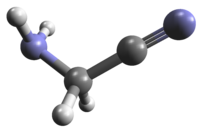|
The present entry is based on a combined fit of
rotational data in the ground and first three excited
vibrational states along with FIR data pertaining to
the three lowest vibrational bands. The data set
concerning the v = 0 rotational transition
frequencies is identical to that of the second entry
of Dec. 2013.
The update is mainly for consistency reasons.
Some improvement occurs especially for transitions
with higher rotational quantum numbers.
With respect to the first entry from Jan. 2008,
extensive mmw and sub-mmW data were published
by
(1) Y. Motoki, Y. Tsunoda, H. Ozeki, and K. Kobayashi,
2013, Astrophys. J. Suppl. Ser., 209, Art. No. 23.
Additional transition frequencies were taken
from
(2) J. N. MacDonald and J. K. Tyler,
1972, J. Chem. Soc. Chem. Comm., 995;
(3) H. M. Pickett
1973, J. Mol. Spectrosc., 46, 335;
(4) M. Bogey, H. Dubus, and J.-C. Guillemin,
1990, J. Mol. Spectrosc., 143, 180;
and from
(5) R. D. Brown, P. D. Godfrey, A. L. Ottrey and J. W. V. Storey,
1977, J. Mol. Spectrosc., 68, 359;
the latter data provided information on the 14N
hyperfine splitting.
In contrast to (1), the data from (5) were used with
hyperfine splitting.
The transition frequencies of excited vibrational states
were reported by
(6) C. Degli Esposti, L. Dore, M. Melosso, K. Kobayashi,
C. Fujita, and H. Ozeki,
2017, Astrophys. J. Suppl. Ser., 230, Art. No. 26.
The transition frequencies of vibrational bands
were reported by
(7) M. Melosso, A. Belloche, M.-A. Martin-Drumel, O. Pirali,
F. Tamassia, L. Bizzocchi, R. T. Garrod, H. S. P. Müller,
K. M. Menten, L. Dore and, C. Puzzarini,
2020, Astron. Astrophys., 641, Art. No. A160.
The spectroscopic parameters of the ground vibrational state
differ slightly from those in (1) and (7). While the first entry
may have been insufficient for radio astronomical observations,
the present entry surely is.
The 14N hyperfine splitting can be resolved
for low values of J. Therefore, a separate
hyperfine calculation is provided up to J" = 6
and up to 60 GHz along with
partition function values.
Please note that the partition function of the main entry
currently considers only the ground vibrational state.
Vibrational factors for a posteriori correction will be provided.
The dipole moment components were determined in (3).
|
